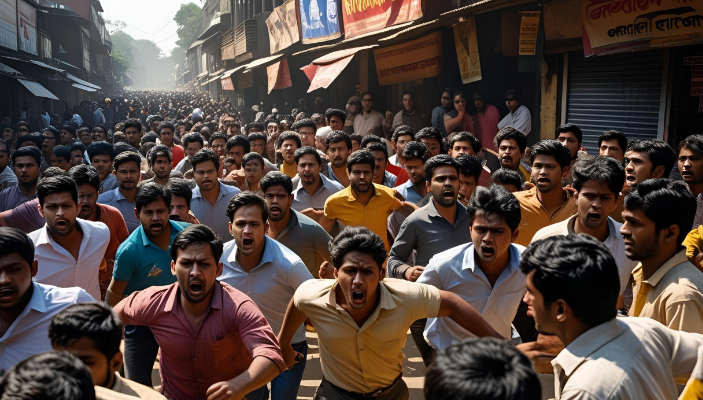A tragic incident occurred during a religious food distribution event in Bangalore, Karnataka, drawing national attention and raising urgent questions about public safety, event planning, and accountability. The stampede led to multiple fatalities and injuries, deeply impacting the local community and grieving families.
The event was intended to be a charitable offering, drawing hundreds of people who gathered to receive food and religious blessings. However, the situation quickly escalated due to poor crowd management, limited entry points, and lack of emergency response planning.
What Led to the Stampede?
1. Event Context and Setup
The gathering took place at a public hall where an annual ritual distribution of offerings was being held. Such events often attract large crowds due to free food distribution, often called annadana in South India, especially in economically vulnerable areas.
On this particular day, the number of attendees far exceeded expectations. Despite past events serving as a benchmark, no significant adjustments were made to accommodate the increase in attendance.
2. Overcrowding and Poor Infrastructure
One of the critical failures was the lack of proper infrastructure. Narrow gates, a single entry and exit point, and limited open space contributed to a high-risk environment. People were asked to form queues, but the line quickly became disorganized due to lack of fencing, poor signage, and no security personnel guiding the crowd.
3. Trigger Incident
As distribution began, people rushed toward the front, fearing that supplies would run out. A sudden push from the rear caused a chain reaction. Individuals at the front lost their footing, falling and causing others to stumble. Within seconds, panic set in. People at the back pushed forward, unaware of the chaos unfolding ahead.
Witnesses reported cries for help and noted that several individuals, including elderly women and children, were trapped underfoot before any intervention could occur.
Casualties and Emergency Response
1. Fatalities and Injuries
According to official sources, multiple people lost their lives, and dozens were injured, with some in critical condition. The majority of victims were women, many of whom had arrived early in the morning and stood in line for hours.
2. Response Time and Limitations
Emergency services arrived after a delay of approximately 25 minutes. While local authorities cited traffic and congestion as contributing factors, this delay proved critical. The absence of on-site medical tents or basic first-aid arrangements highlighted a serious oversight in planning.
3. Rescue and Evacuation Challenges
Police and medical staff had difficulty entering the crowded area. Volunteers and bystanders had to step in initially to lift injured persons and move them to safer spots. The disorganized response further intensified the crisis.
Accountability and Reactions
1. Government and Political Response
The Karnataka state government ordered an investigation and announced compensation for the victims’ families. However, public sentiment remained skeptical. Critics argued that such announcements are reactive, not preventive, and questioned why no crowd safety protocols were in place for an event of this scale.
2. Organizers Under Scrutiny
Organizers, which included a mix of local religious groups and community leaders, are now facing legal scrutiny. Allegations of negligence have surfaced, particularly around their failure to coordinate with municipal authorities or hire professional security staff.
3. Public and Media Opinion
Social media and local news outlets highlighted how this was not an isolated event. Previous incidents in various parts of India have shown similar patterns — poorly planned large gatherings leading to loss of life. There is growing public demand for stringent guidelines and accountability for public events, especially when organized in densely populated areas.
Socioeconomic Impact and Underlying Issues
1. Why People Risk Their Lives for Free Food
The high turnout was not merely a cultural or religious act — it was a reflection of economic hardship. For many attendees, especially from lower-income communities, such events are one of the few sources of free meals and basic necessities. This brings into focus deeper issues related to food security, unemployment, and inequality.
2. Need for Reform in Public Event Policies
This tragic event has sparked conversations among policymakers, urban planners, and civil society organizations about crowd regulation. There is a need to adopt standard operating procedures (SOPs) based on international best practices, such as:
- Mandatory event permits for gatherings above a certain size.
- Deployment of trained crowd control personnel.
- Setup of medical response units on site.
- Use of real-time surveillance systems and loudspeaker guidance.
Learning from the Incident
1. Urban Safety and Human Behavior
Crowd behavior under stress can change rapidly. People respond to perceived scarcity or fear with urgency, often resulting in chaos. In this incident, the lack of organized queue management and fear of missing out on food were key contributors.
Designing safer public events isn’t only about managing space — it’s about understanding human psychology and preparing accordingly. Controlled flow design, adequate spacing, and trained communication staff can significantly reduce risks.
2. Preventive Steps Moving Forward
To ensure such tragedies are not repeated, city governments need to:
- Mandate professional event safety audits.
- Educate event organizers on risk management.
- Use local radio and mobile alerts to guide public behavior in real time.
- Encourage partnerships between community groups and emergency response agencies.
Conclusion
The Bangalore stampede was not just a moment of panic — it was a tragic result of overlooked safety practices, misjudged crowd size, and social conditions that left people vulnerable. While investigations and legal processes continue, the broader takeaway is the urgent need to rethink how large-scale public events are organized, especially in economically diverse regions.
The lives lost were not just numbers; they were individuals who came seeking help and left their families in grief. It is a collective responsibility — of planners, leaders, and citizens — to ensure that empathy is matched with preparation and foresight.
Let this be a turning point where respect for life and commitment to safety take precedence over ceremonial grandeur.

